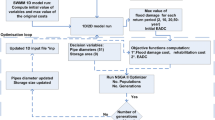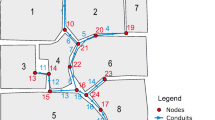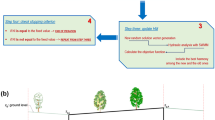Abstract
In order to mitigate urban flooding and combined sewer overflows, an integrated assessment method was proposed to identify the optimum reconstruction scheme of a drainage system by considering environment, economy, and society. The integrated assessment framework consisted of the drainage system model establishment, analytic hierarchy process theory, and regret value method. Five drainage system reconstruction schemes for Chaohu city were proposed in this study, and they were evaluated according to nine assessment factors by the integrated assessment method at the initial and future stages. The integrated assessment results show that setting up interceptive equipment for a combined drainage network is the optimal reconstruction scheme at both the initial and future stages of the life cycle. This means that an interceptive combined drainage network is better than a separate drainage network or setting up storage tanks in particular situations from a comprehensive perspective.







Similar content being viewed by others
References
Artina S, Bolognesi A, Liserra T, Maglionico M (2007) Short communication: simulation of a storm sewer network in industrial area: comparison between models calibrated through experimental data. Environ Model Softw 22(8):1221–1228
Baffaut C, Delleur JW (1989) Expert system for calibrating SWMM. J Water Res Plan Man 115(3):278–298
Bisht DS, Chatterjee C, Kalakoti S, Upadhyay P, Sahoo M, Panda A (2016) Modeling urban floods and drainage using swmm and mike urban: a case study. Nat Hazards 84(2):749–776
Brombach H, Weiss G, Fuchs S (2005) A new database on urban runoff pollution: comparison of separate and combined sewer systems. Wat Sci Tech 51(2):119–128
Carter T, Keeler A (2008) Life-cycle cost-benefit analysis of extensive vegetated roof systems. J Environ Manag 87(3):350–363
Casal-Campos A, Fu G, Butler D, Moore A (2015) An integrated environmental assessment of green and gray infrastructure strategies for robust decision making. Environ Sci Technol 49(14):8307–8314
Chen H, Liao Z, Gu X, Xie J, Li H, Jin Z (2017) Anthropogenic influences of paved runoff and sanitary sewage on the dissolved organic matter quality of wet weather overflows: an excitation–emission matrix parallel factor analysis assessment. Environ Sci Technol 51(3):1157–1167
Chou JS, Yeh KC (2015) Life cycle carbon dioxide emissions simulation and environmental cost analysis for building construction. J Clean Prod 101:137–147
Chua LHC, Wong TSW (2010) Improving event-based rainfall-runoff modeling using a combined artificial neural network-kinematic wave approach. J Hydrol 390(1):92–107
Crabtree RW, Ashley R, Gent R (1995) Mousetrap: modelling of real sewer sediment characteristics and attached pollutants. Wat Sci Tech 31(7):43–50
Delporte C, Pujol R, Vion P (1995) Optimized lamellae settling for urban stormwater waste. Wat Sci Tech 32(1):127–136
Elliott AH, Trowsdale SA (2007) A review of models for low impact urban stormwater drainage. Environ Model Softw 22(3):394–405
Even S, Mouchel JM, Servais P, Flipo N, Poulin M, Blanc S, Chabanel M, Paffoni C (2007) Modelling the impacts of combined sewer overflows on the river seine water quality. Sci Total Environ 375(1–3):140–151
Garsdal H, Mark O, Dørge J, Jepsen SE (1995) Mousetrap: modelling of water quality processes and the interaction of sediments and pollutants in sewers. Wat Sci Tech 31(7):33–41
Ghobadi Y, Pradhan B, Sayyad GA, Kabiri K, Falamarzi Y (2015) Simulation of hydrological processes and effects of engineering projects on the karkheh river basin and its wetland using swat2009. Quatern Int 374:144–153
Godfrey S, Hailemichael G (2017) Life cycle cost analysis of water supply infrastructure affected by low rainfall in Ethiopia. J Water Sanit Hyg De 7(4):601–610
Gu X, Liao Z, Zhang G, Xie J, Zhang J (2017) Modelling the effects of water diversion and combined sewer overflow on urban inland river quality. Environ Sci Pollut R 24(26):21038–21049
Gujer W, Boller M (1990) A mathemetical model for rotating biological contactors. Wat Sci Tech 22:53–73
Gupta PK, Chauhan S, Oza MP (2016) Modelling surface run-off and trends analysis over India. J Earth Syst Sci 125(6):1–14
Hamid A, Wallace L, Bell D (2001) City of Atlanta combined and separate sewer overflow control program meets the challenge of the 21st century. Proc Water Environ Fed 2001(16):579–593
Hatt BE, Fletcher TD, Walsh CJ, Taylor SL (2004) The influence of urban density and drainage infrastructure on the concentrations and loads of pollutants in small streams. Environ Manag 34(1):112–124
Hellmers S, Manojlovic N, Palmaricciotti G, FroHle P (2016) Modelling decentralised systems for urban drainage and flood mitigation. J Applied Water Eng Res 5(1):61–69
Hellström D, Jeppsson U, Kärrman E (2000) A framework for systems analysis of sustainable urban water management. Environ Impact Assessment Rev 20(3):311–321
Kang H, Li X, Wang J, Zhang J (2016) Evaluating ecological vulnerability using the GIS and analytic hierarchy process (AHP) method in Yan’an, China. Pol J Environ Stud 25(2):599–605
Kumar R, Chatterjee C, Singh RD, Lohani AK, Kumar S (2010) Runoff estimation for an ungauged catchment using geomorphological instantaneous unit hydrograph (giuh) models. Hydrol Process 21(14):1829–1840
Ji Z (1998) General hydrodynamic model for sewer/channel network systems. J Hydrol Eng 124(3):307–315
Joyce J, Ruppert T, Ruppert T, Ruppert T, Imen S (2017) Developing a multi-scale modeling system for resilience assessment of green-grey drainage infrastructures under climate change and sea level rise impact. Environ Model Softw 90:1–26
Lai E, Lundie S, Ashbolt NJ (2008) Review of multi-criteria decision aid for integrated sustainability assessment of urban water systems. Urban Water J 5(4):315–327
Larsen TA, Gujer W (1997) The concept of sustainable urban water management. Wat Sci Tech 35(9):3–10
Lázaro JM, Navarro JÁS, Gil AG, Romero VE (2015) A new adaptation of linear reservoir models in parallel sets to assess actual hydrological events. J Hydrol 524:507–521
Liao Z, Chen H, Huang F, Li H (2015a) Cost-effectiveness analysis on lid measures of a highly urbanized area. Desalin Water Treat 56(11):2817–2823
Liao Z, Zhang G, Wu Z, He Y, Chen H (2015b) Combined sewer overflow control with lid based on swmm: an example in Shanghai, China. Wat Sci Tech 71(8):1136–1142
Lindholm OG (1975) Factors affecting the performance of combined versus separate sewer systems. Prog Wat Tech 2(7):265–276
Mannina G, Viviani G (2009) Separate and combined sewer systems: a long-term modelling approach. Wat Sci Tech 60(3):555–565
Matinzadeh MM, Koupai JA, Sadeghi-Lari A, Nozari H, Shayannejad M (2017) Development of an innovative integrated model for the simulation of nitrogen dynamics in farmlands with drainage systems using the system dynamics approach. Ecol Model 347:11–28
Meng M, Wu Y, Gui Y (2011) Utilization of rainwater source in Shanghai. Water Purif Technol 30(5):43–47
Nielsen PH, Raunkjær K, Norsker NH, Jensen NA, Hvitved-Jakobsen T (1992) Transformation of wastewater in sewer systems. A review. Wat Sci Tech 25(6):17–31
Obropta CC, Kardos JS (2010) Review of urban stormwater quality models: deterministic, stochastic, and hybrid approaches. J Am Water Resour As 43(6):1508–1523
Peng H, Liu Y, Wang H, Ma L (2015) Assessment of the service performance of drainage system and transformation of pipeline network based on urban combined sewer system model. Environ Sci Pollut R 22(20):15712–15721
Qiu C, Hattori Y, Kaji M, Onodera M, Hitokoto M (2014) Development of a river flow forecast model by coupling a snow accumulation/melt model with a distributed run-off model. J Flood Risk Manag 7(1):89–99
Quinn R, Dussaillant A (2014) Predicting infiltration pollutant retention in bioretention sustainable drainage systems: model development and validation. Hydrol Res 45(6):855–867
Semadeni-Davies A, Hernebring C, Svensson G, Gustafsson LG (2008) The impacts of climate change and urbanisation on drainage in Helsingborg, Sweden: suburban stormwater. J Hydrol 350(1–2):114–125
Thorndahl S, Schaarup-Jensen K, Rasmussen MR (2015) On hydraulic and pollution effects of converting combined sewer catchments to separate sewer catchments. Urban Water J 12(2):120–130
Wang J, Da L, Song K, Li B (2008) Temporal variations of surface water quality in urban, suburban and rural areas during rapid urbanization in shanghai, China. Environ Pollut 152(2):387–393
Wu H, Huang G, Meng Q, Zhang M, Li L (2016) Deep tunnel for regulating combined sewer overflow pollution and flood disaster: a case study in Guangzhou City. China Water-Sui 8(8):329
Xie J, Chen H, Liao Z, Gu X, Zhu D, Zhang J (2017) An integrated assessment of urban flooding mitigation strategies for robust decision making. Environ Model Softw 95:143–155
Xin D, Hao G, Zeng S (2017) Enhancing future resilience in urban drainage system: green versus grey infrastructure. Water Res 124:280–289
Xue C, Yin H, Xie M (2015) Development of integrated catchment and water quality model for urban rivers. J Hydrol 27(4):593–603
Xu H (2014) Area peak flow coefficient comprehensive frequency curve method and hydrologic analogy comparison of calculated peak flow. Water Conservancy Science and Technology and Economy 20(5):40–42
Xu Z, Liao Z (2013) A systematic view is key: the successful case of Suzhou Creek rehabilitation. Environ Sci Technol 47(21):11936–11937
Zhang W, Li T (2015) Particle size distributions in combined sewer overflows in a high-intensity urban catchment in Shanghai, China. Desalin Water Treat 56(3):655–664
Zhou Q, Mikkelsen PS, Halsnæs K, Arnbjerg-Nielsen K (2012) Framework for economic pluvial flood risk assessment considering climate change effects and adaptation benefits. J Hydrol 414(2):539–549
Zhou Q, Panduro TE, Bo JT, Arnbjergnielsen K (2013) Adaption to extreme rainfall with open urban drainage system: an integrated hydrological cost-benefit analysis. Environ Manag 51(3):586–601
Zhou Q (2014) A review of sustainable urban drainage systems considering the climate change and urbanization impacts. Water-Sui 6(4):976–992
Zoppou C (2001) Review of urban storm water models. Environ Model Softw 16(3):195–231
Zyoud SH, Shaheen H, Samhan S, Rabi A, Al-Wadi F, Fuchs-Hanusch D (2016) Electronic offprint utilizing analytic hierarchy process (AHP) for decision making in water loss management of intermittent water supply systems. J Water Sanit Hyg De 6(4):534–546
Funding
This study is financially supported by the National Natural Science Foundation of China (grant no. 51578396 and grant no. 51778451), the National Key R&D Program of China (grant no. 2016YFE0123300), and the Key Project of Shanghai Municipal Science and Technology Commission (grant no.17DZ1202100). We also thank the 111 Project (B13017) of Tongji University.
Author information
Authors and Affiliations
Corresponding author
Ethics declarations
Conflict of interest
The authors declare that they have no conflict of interest.
Additional information
Responsible editor: Marcus Schulz
Publisher’s note
Springer Nature remains neutral with regard to jurisdictional claims in published maps and institutional affiliations.
Electronic supplementary material
ESM 1
(DOCX 5124 kb)
Rights and permissions
About this article
Cite this article
Liao, Z., Gu, X., Xie, J. et al. An integrated assessment of drainage system reconstruction based on a drainage network model. Environ Sci Pollut Res 26, 26563–26576 (2019). https://doi.org/10.1007/s11356-019-05280-1
Received:
Accepted:
Published:
Issue Date:
DOI: https://doi.org/10.1007/s11356-019-05280-1




